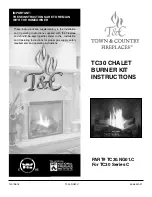
Page 38
POSSIBLE PROBLEMS
Problems encountered with operation of catalytic-combustor equipped wood heaters are usually the same as those
experienced in operation of traditional wood heaters. Our experience has shown that adoption of good operating
practices will eliminate most of these problems. In addition, it should be noted that problems with catalytic
combustors are rare. Fewer than 1 percent of combustors are returned for any reason. Nonetheless, installers and
retailers should make themselves aware of nature, cause and solution to possible problems so as to serve their
customers better.
Plugging-Plugging can occur if combustor is operated improperly. It may occur if wrong materials are burned.
Evidence of these types of plugging is a coating of black soot, creosote or fly ash on combustor. Burning materials
that produce large flakes of char, such as Christmas wrapping paper or cardboard, can plug enough cells to cause
smoke spillage.
Extreme Temperature-A combustor becomes extremely hot during operation. Temperatures between 1400
o
F and
1600
o
F (760
o
C - 870
o
C) are common, but operating temperatures between 1200
o
F and 1400
o
F (650
o
C - 760
o
C)
are recommended. Most of this heat is transmitted to surrounding heater parts via thermal radiation.
Flow Restrictions-Because combustor is mounted in gas flow stream, it does offer resistance to draft. This
restriction or resistance presents two problems:
If the bypass is not open when fuel-loading door is opened, smoke rollout will occur.
Chimneys that produce marginal draft may prevent operation of a combustor-equipped device. A chimney
that provides, on average, .02” of water draft in low
-fire operation would probably not operate with a catalytic
combustor appliance in low-fire mode. In such a case, combustor resistance would offset remaining draft,
resulting in a system that will not draft.
Creosote Build-up-Even though reduction of creosote is one of primary advantages of a combustor-equipped
device, some creosote-forming gases will escape unburned during normal operation. In event combustor ceases to
function, creosote can be expected to accumulate. Consequently, flues and chimneys should be inspected regularly
(every 2-3 months of operation) and any creosote build-up removed. Failure to do this could result in a chimney
fire.
Chemical Deactivation-Deactivation can occur when catalyst is attacked by materials such as compounds of
sulphur, phosphorus or lead and other heavy metals. Burning large quantities of trash, pressure-treated lumber or
painted wood can deactivate catalyst. The operator takes a chance when burning anything other than natural wood.
The catalysts are durable and are not likely to be greatly affected by an occasional mistake, but burning large
quantities of chemical-laden materials will appreciably shorten life of combustor. The catalyst can also be
deactivated when it is coated with excessive creosote, carbon or fly ash. This build-up greatly reduces the amount
of catalyst available to react with the smoke.
Excessive Handling-
An older combustor, especially one that is “uncanned”, is susceptible to handling damage.
Stress-relief cracks may develop in service but will not affect performance of combustor if it is not moved or
handled. Handling a unit with these cracks, however, could result in it breaking apart. Excessive handling could
also potentially remove some of catalyst coating.
Condensation In Chimney-The burning that takes place in a combustor converts harmful hydrocarbons and
carbon monoxide to heat, carbon dioxide and water. The additional water produced by this complete burning can
lead to associated problems in the chimney.
Содержание MODEL 20
Страница 2: ......
















































